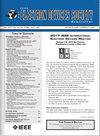油藏计算网络中实现长短期记忆的交叉温度效应
IF 2.4
3区 工程技术
Q3 ENGINEERING, ELECTRICAL & ELECTRONIC
引用次数: 0
摘要
基于新兴的非易失性存储器的硬件神经网络是克服冯·诺依曼计算瓶颈的有希望的候选人。本文研究了铁电场效应晶体管(fefet)的器件特性和可靠性,重点研究了它们的温度依赖性性能。在300 K时,ffet显示出6.2 V的记忆窗口(MW),在107个程序/擦除(P/E)循环后,耐久性下降26.4%,在104 s后保持92.39%。加速电荷捕获/去捕获动态实现卓越的短期记忆(STM)功能。值得注意的是,77 K的低温操作将MW提高到8 V,同时获得了出色的稳定性,107次循环后仅下降0.4%,104秒保持99.02%。增强的特性使其成为长期记忆(LTM)应用程序的理想选择。此外,提出了一种基于交叉温度效应场效应的储层计算网络。通过综合300 K时的STM特性和77 K时的LTM优势,本文提出的RC网络在CIFAR-10图像识别任务上的分类准确率达到76.73%。这超过了300 K和77 K条件下分别41.65%和23.69%的独立结果。这一发现突出了在不同温度系统下开发高能效的基于feet的神经形态计算的潜力。本文章由计算机程序翻译,如有差异,请以英文原文为准。
Cross-Temperature FeFETs Enabling Long- and Short-Term Memory for Reservoir Computing Network
Hardware neural networks based on emerging nonvolatile memory are promising candidates to overcome the Von Neumann computing bottleneck. This study investigates the device characteristics and reliability of ferroelectric field-effect transistors (FeFETs) with a focus on their temperature-dependent performance. At 300 K, the FeFET demonstrates a 6.2 V memory window (MW) with 26.4% endurance degradation after 107 program/erase (P/E) cycles and 92.39% retention after 104 s. The accelerated charge trapping/detrapping dynamics enable superior short-term memory (STM) functionality. Remarkably, cryogenic operation at 77 K enhances the MW to 8 V while achieving exceptional stability with merely 0.4% degradation after 107 cycles and 99.02% retention at 104 seconds. The enhanced characteristics make it ideal for long-term memory (LTM) applications. Moreover, a reservoir computing (RC) network is proposed based on the cross-temperature FeFETs. By integrating the STM properties at 300 K and the LTM benefits at 77 K, the proposed RC network achieves a classification accuracy of 76.73% on the CIFAR-10 image recognition task. This surpasses the standalone results of 41.65% and 23.69% of 300 K and 77 K conditions, respectively. The findings highlight the potential to develop highly energy-efficient FeFET-based neuromorphic computing with varying temperature systems.
求助全文
通过发布文献求助,成功后即可免费获取论文全文。
去求助
来源期刊

IEEE Journal of the Electron Devices Society
Biochemistry, Genetics and Molecular Biology-Biotechnology
CiteScore
5.20
自引率
4.30%
发文量
124
审稿时长
9 weeks
期刊介绍:
The IEEE Journal of the Electron Devices Society (J-EDS) is an open-access, fully electronic scientific journal publishing papers ranging from fundamental to applied research that are scientifically rigorous and relevant to electron devices. The J-EDS publishes original and significant contributions relating to the theory, modelling, design, performance, and reliability of electron and ion integrated circuit devices and interconnects, involving insulators, metals, organic materials, micro-plasmas, semiconductors, quantum-effect structures, vacuum devices, and emerging materials with applications in bioelectronics, biomedical electronics, computation, communications, displays, microelectromechanics, imaging, micro-actuators, nanodevices, optoelectronics, photovoltaics, power IC''s, and micro-sensors. Tutorial and review papers on these subjects are, also, published. And, occasionally special issues with a collection of papers on particular areas in more depth and breadth are, also, published. J-EDS publishes all papers that are judged to be technically valid and original.
 求助内容:
求助内容: 应助结果提醒方式:
应助结果提醒方式:


